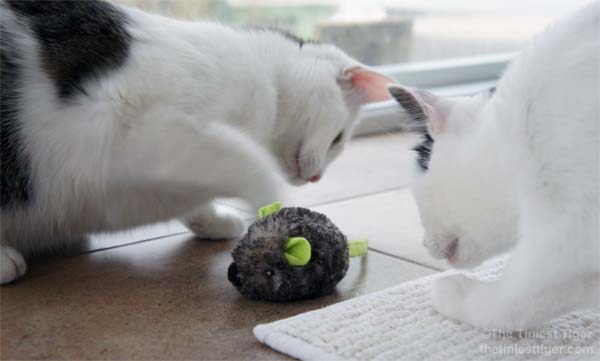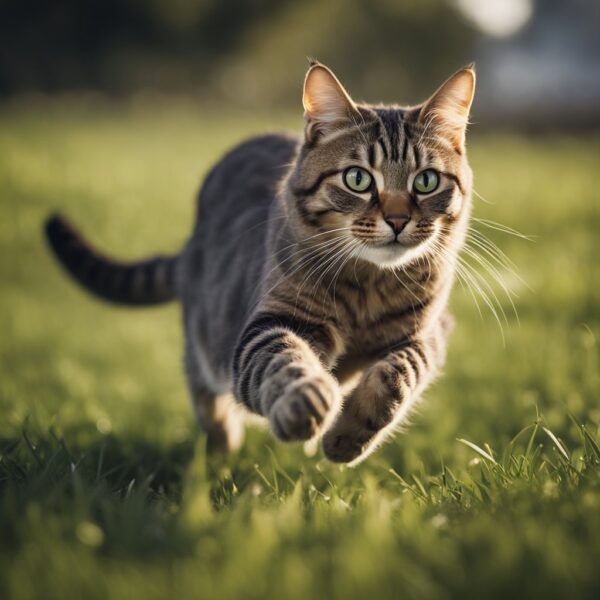
Cats Wiggle Before Pouncing: Pre-Pounce Ritual
Cats are known for their stealth and agility, especially when it comes to hunting or playing. One peculiar behavior that has piqued the curiosity of cat parents and feline enthusiasts alike is the way cats wiggle their behind before they pounce. This pre-pounce ritual is not just a cute quirk; it plays a vital role in preparing the feline to launch itself at its target with precision.
The wiggle serves several practical purposes. It allows the cat to test the stability of the ground beneath its feet and ensure a firm launching pad. Additionally, this movement may aid in fine-tuning the cat’s muscle coordination and increase the efficiency of the pounce. The behavior also activates a cat’s hunting instincts and mental focus, preparing them for the chase or capture of their prey or toy.
Key Takeaways
- Cats wiggle their behinds before pouncing to ensure stability and readiness.
- The behavior plays a role in muscle coordination and mental preparation for hunting.
- It reflects a complex interplay of physical and instinctive feline attributes.

The Science of the Wiggle
The feline butt wiggle before pouncing is a complex behavior rooted in biomechanics and hunting instincts, shaping the precision and agility found in both domestic and wild cats.
Understanding Feline Muscle Mechanics
In anticipation of a pounce, cats engage in a characteristic rear wiggle to prime their hind leg muscles for the intense activity. This motion involves stretching and contracting the muscles, effectively preparing them for the sudden explosive energy release needed to spring towards their target.
Insights into Feline Hunting Behavior
This preparatory wiggle is deeply ingrained in the cat’s hunting repertoire, enhancing not only muscle readiness but also focus on the prey. Cats from nimble house felines to larger predators like lions and tigers use this behavior to refine their hunting skills and improve the accuracy of their attack.
The Role of Traction and Stability
Traction and stability are crucial when a cat launches itself into the air. The butt wiggle aids in checking ground traction and ensuring stability for a balanced launch and a controlled land. Good footing prevents slipping, allowing for a full-force leap without waste of energy.
Evolutionary Biomechanics at Play
Over time, this wiggling action has been refined by evolutionary biomechanics, becoming a seamless part of the cat’s hunting instincts. Such instinctual behaviors are prominent across various species of cats, indicating a successful survival strategy.
Proprioception and Cat Pouncing
Proprioception, or the body’s ability to sense its position and movement, is critical in a cat’s pounce. The butt wiggle is linked to proprioceptive feedback, where neural commands adjust for precision, enabling the cat to gauge the optimal moment to spring and catch its prey with astonishing coordination.

The Pre-Pounce Ritual: Cats in Action
Observing a cat in the midst of a pounce reveals a complex blend of instinct, anticipation, and a tactical approach to engaging with their target.
Preparation and Anticipation in Cat Pouncing
Cats exhibit a distinct preparatory behavior when they set their sights on a target. The wiggle—a pronounced movement of their behind—serves as a physical and mental readiness ritual. They are not only preparing their muscles for the sudden burst of energy required for pouncing but also anticipating the thrill of the chase, whether it’s prey or a toy.
- Preparation: Aligning their body for optimal balance and power.
- Anticipation: Heightening their focus and excitement for the ensuing action.
Analyzing the Pounce Technique
The pouncing technique is a meticulous process where the cat assesses distance and trajectory to ensure an accurate leap. Butt wiggling helps them test the ground beneath and determine the stability before they launch themselves toward the target. Precision in tracking their moving target is critical, with the pounce being the culmination of their focused tracking behavior.
- Tracking: Locking their gaze on the target to maintain a clear line of sight.
- Pounce: Executing the leap with precise timing and power.
Cats’ Emotional Connection to Pouncing
Pouncing is not just a physical act for cats but also an emotional experience. The release of dopamine during the anticipation and play phase leads to a sense of pleasure and joy. This behavior is especially evident when cat parents engage with their cats, providing an outlet for their excitement and instinctual pouncing behavior.
- Dopamine: Fuels the excitement and rewards the cat with feelings of pleasure.
- Emotional connection: Strengthens the bond between cat and owner during playtime.

The Pre-pounce ritual and The Physics of Pouncing
The precise mechanics of a cat’s pounce involve a complex interplay of biology and physics, optimizing power and precision through various preparatory behaviors and anatomical adaptations.
Analyzing the Pounce: Power and Precision
The cat wiggle before pouncing is a behavior that exhibits a powerful combination of strength and accuracy. As they coil and unleash their hind legs, this preparatory movement optimizes the contraction of muscles necessary for an explosive jump. Each pounce requires immense power and precision; the former to launch the cat through the air and the latter to ensure an accurate landing onto the targeted prey.
The Impact of Ground and Environment
Surface conditions directly affect a cat’s pounce. Ideal traction between the hind legs and the ground is key, as it prevents slippage and maximizes the force for the jump. Friction must be adequate to convert muscular energy into motion without loss due to environmental factors. This dynamic is similar to athletes ensuring their footwear is suitable for the terrain to prevent injury and enhance performance.
The Importance of Warm Up and Blood Flow
Like human athletes, cats benefit from warming up. The subtle cat wiggle not only aids in assessing ground friction but also serves as a warm-up, enhancing blood flow to the leg muscles. This is critical for averting muscle injuries during these explosive movements. Increased blood flow ensures muscles are oxygen-rich and limber, reducing the risk of strains.
Cats’ Landing Techniques and Injury Prevention
The landing is as significant as the launch in a cat’s pounce. Cats are known to land on their toes, which act as shock absorbers, dispersing the impact of the jump. Such technique minimizes stress on the skeleton and muscles, acting as an effective injury prevention measure. Kittens often instinctively practice to perfect both the pounce and landing, reducing the chances of harm while honing their hunting skills, which are vital in cat behavior.

Feline Interaction with Their Prey and Toys
Cats engage in complex behaviors when interacting with prey and toys, utilizing them not only for practice but also as a means of communication. These behaviors serve to hone their hunting skills and express their instincts.
Toys as Tools for Hunting Simulation
Domestic cats often rely on toys to simulate the experience of hunting. When a cat plays with a toy, it mimics the stalking and pouncing actions that would be used in the wild to catch prey. This play is not only crucial for their mental and physical stimulation but also helps fine-tune their natural instincts.
- Stalk: The cat crouches low to the ground, eyes locked on the target.
- Wiggle: Just before the pounce, the hindquarters wiggle to prepare for the leap.
- Pounce: With a burst of energy, the cat leaps towards the toy, attempting to capture it.
The Communication Through Body Language
The body language of a cat, especially the tail, can communicate their intention to play or hunt. A cat’s poised tail can indicate focus and readiness, while the iconic tail twitch demonstrates excitement or agitation. Tail twitching and the “butt wiggle” are visual cues to their human owners or fellow felines that they are in a playful or predatory mood.
Observing Domestic Versus Wild Cat Behavior
Comparing domestic cats to their wild counterparts like lions, tigers, and leopards can offer insights into inherent feline behaviors. Both house cats and big cats engage in similar preparatory behaviors before a pounce, such as:
- Focused vision on prey.
- A tense, wiggling posture to gather energy.
- The pursuit phase after careful stalking.
Wild cats display these behaviors on a larger scale when hunting real prey, while domestic cats may exhibit them in a more playful context. Regardless, these actions fulfill innate needs for both groups.
The Social and Evolutionary Perspectives
The intricacies of feline pouncing behavior connect to both social communication within groups and the larger evolutionary context of cat breeds. This section examines these perspectives in detail.
Social Significance of Pouncing in Feline Groups
In feline groups, pouncing is not only a hunting technique but also serves as a social behavior for communication among cats. When domestic cats or their wild counterparts engage in playful pouncing, they are also practicing vital survival skills and establishing social hierarchies. Feline behavior experts observe that through these playful bouts, kittens learn to gauge their strength and refine their agility, establishing their position within the group.
Understanding the Evolution of Cat Breeds and Pouncing
The evolution of different cat breeds has been influenced by humans through selective breeding. However, despite the variety in appearance and temperament, all domestic cats retain the instinctual behavior of pouncing, rooted in their shared ancestry. Notably, evolutionary biomechanics play a significant role in how breeds with different physical attributes execute the pounce. For instance, breeds with longer limbs may pounce from farther distances than those with shorter limbs. Academic research indicates that the shared ancestry of domesticated cats has preserved this behavior across all breeds.
Expert Opinions on Feline Pounce Dynamics
Scientists and behaviorists, through academic research and observation, have analyzed pouncing dynamics to gain insights into feline behavior. They suggest that the preparatory butt wiggle seen in cats is an instinctive action allowing for a more precise and powerful pounce. According to Live Science, experts propose that this motion provides a dual function—a final assessment of stability and an increase in muscle readiness, enhancing the pounce’s effectiveness. Such behaviors, while seemingly playful, are a display of the complex interplay between innate instinct and learned behavior in feline evolution.

Frequently Asked Questions about Pre-pounce ritual
This section addresses common inquiries about the intriguing behavior of the cat wiggle before pouncing, providing clear explanations for the actions observed in domestic and large feline species.
Why do cats shake their backside before leaping at a target?
Cats wiggle their backside before pouncing to achieve better stability and precision during their pounce. This action helps them ensure that all four paws are positioned for maximum balance and force.
Is the wiggling motion before a pounce common behavior in large feline species?
Yes, the wiggling motion before a pounce is also observed in large feline species. It serves a similar purpose in helping these bigger cats assess their footing and prepare their muscles for a powerful leap.
What is the purpose of a cat’s tail wiggle before it attacks?
A cat’s tail wiggle before it attacks acts as a preparatory movement that can help with balance and focus. The tail motion may also serve as a final adjustment to the cat’s hunting position before striking.
How do felines prepare themselves before attempting to catch prey?
Felines prepare themselves before attempting to catch prey by crouching, focusing on the target, and performing the characteristic rear-end wiggle. This behavior optimizes their body alignment for a swift and effective attack.
What are the behavioral reasons behind a cat’s pounce on their guardian?
A cat’s pounce on their guardian is often a form of play and social interaction rather than aggression. It can be an expression of trust and affection, replicating hunting behaviors in a non-threatening context.
Can the pre-pounce wiggle in cats be linked to their hunting instincts?
The pre-pounce wiggle in cats is closely linked to their hunting instincts. This movement primes their bodies for the explosive movement required to catch prey, showcasing their innate predatory behavior.